| Skip Navigation Links | |
| Exit Print View | |

|
Master Index Data Manager User's Guide Java CAPS Documentation |
| Skip Navigation Links | |
| Exit Print View | |

|
Master Index Data Manager User's Guide Java CAPS Documentation |
Master Index Data Manager User's Guide
About the Master Index Data Manager
About Oracle Java CAPS Master Index
About Master Index Applications
Features of Master Index Applications
Functions of the Master Index Data Manager
Learning about MIDM Object Profiles
MIDM Object Profile Components
Source Record and SBR Components in a Master Index
Identification Numbers for each Entity in the Master Index
Working with the Master Index Data Manager
Logging in to the Master Index Data Manager
Master Index Data Manager Security Permissions
Master Index Data Manager Navigation Tips
Navigating the MIDM Detail Pages
Viewing Summary Information From the Dashboard
Accessing Reports and Audit Logs From the Dashboard
To Access Reports and Audit Logs From the Dashboard
Performing a Quick Search (EUID Lookup)
Performing an EUID Comparison Lookup
To Perform an EUID Comparison Lookup
Learning About Object Queries on the MIDM
About the MIDM Search Function
Searching by Ranges on the MIDM
Searching for Object Profiles on the MIDM
Performing an Alphanumeric Search
To Perform an Alphanumeric Search
Performing an EUID Comparison Lookup
To Perform an EUID Comparison Lookup
Working with Search Results on the MIDM
Viewing the Results of a Search
Selecting a Profile from the Results List
Sorting the Results of Your Search
Learning About Object Profile Views on the MIDM
Object Profile Details on the MIDM
Source Record Details on the MIDM
Object Profile and Source Record Comparisons
Object Profile Transaction Histories
Object Profile Merge Histories on the MIDM
Viewing Object Information on the MIDM
Viewing Object Profiles on the MIDM
Viewing a Source Record on the MIDM
Comparing Object Information on the MIDM
Comparing Two or More Object Profiles
Comparing Source Records From Object Profile Views
Comparing Source Records From One Source System
Viewing Transaction Histories on the MIDM
To View a Complete Transaction History For an Object Profile
To View Transaction History Records from the Transactions Page
About Transaction History Search Fields on the MIDM
About Transaction History Results Fields on the MIDM
Transaction History Transaction Types on the MIDM
Viewing a Profile's Merge History on the MIDM
To View an Object's Merge History
Viewing Merged Profiles for an Object Profile
To View Merged Profiles for an Object Profile
About Audit Log Search Fields on the MIDM
Adding an Object Profile on the MIDM
Step 1: Obtain Information about the Object
Step 2: Specify a System and Local ID
To Specify a System and Local ID
Step 3: Specify Parent Object Information
To Specify Parent Object Information
Step 4: Specify Child Object Information
To Specify Child Object Information
Step 5: Save the Object Profile
Learning About MIDM Maintenance Tasks
Surviving and Non-Surviving Profiles
Handling Potential Duplicates on the MIDM
Linking Source Record Fields to the SBR
Locking Field Values in the SBR
Modifying Profile Information on the MIDM
Modifying Information in an Object Profile
Modifying Parent Object Information in a Profile
Adding a Child Object to an Object Profile
Modifying a Child Object in a Profile
Deleting a Child Object From a Profile
Modifying Information Directly in a Source Record
Modifying the Parent Object in a Source Record
Adding a Child Object to a Source Record
Modifying a Child Object in a Source Record
Deleting a Child Object From a Source Record
Overriding the Survivor Calculator's SBR
Linking an SBR Field to a Specific Source Record
Unlinking an SBR Field From a Source Record
Adding a Source Record to an Object Profile
To Add a Source Record to an Object Profile
Deactivating a Profile or Source Record
Deactivating an Object Profile
Reactivating a Profile or Source Record
Reactivating an Object Profile
Working with Potential Duplicate Profiles on the MIDM
Finding Potential Duplicate Profiles on the MIDM
About Duplicate Records Search Fields on the MIDM
Merging Potential Duplicate Profiles
To Combine Duplicate Profiles From the Comparison Page
Resolving Potential Duplicate Profiles on the MIDM
To Resolve Potential Duplicate Profiles From the Results List
To Resolve Potential Duplicate Profiles From the Comparison Page
Unresolving Potential Duplicate Profiles on the MIDM
To Unresolve Potential Duplicate Profiles From the Results List
To Unresolve Potential Duplicate Profiles From the Comparison Page
Working with Assumed Matches on the MIDM
Finding Assumed Matches on the MIDM
About Assumed Matches Search Fields
About Assumed Match Results Fields on the MIDM
Reversing an Assumed Match on the MIDM
Combining Object Information on the MIDM
Merging Object Profiles on the MIDM
Merging Source Records on the MIDM
Unmerging Object Information on the MIDM
Unmerging Object Profiles on the MIDM
Unmerging Source Records on the MIDM
The MIDM displays object profiles in a series of pages from which you can search for, select, and view object profiles. You can view information associated with any of the SBR or source record components in an object profile. The SBR contains the information that is determined to be the most current and accurate information about that object from all external systems.
The source records associated with a profile contain information that is stored in the external systems that share information with the master index application. The information in a source record might not match the information in the SBR. You can view information about an object in several different ways, including the following:
The Record Details page displays object profiles in a series of pages from which you can select and view profiles. You can view information associated with any of the SBR or source record components in an object profile. The SBR contains the information that is determined to be the most current and accurate information about that object from all local systems. By default, when the Record Details page first appears in view mode, only the information in the SBR is visible.
Figure 16 Record Details Page in View Mode
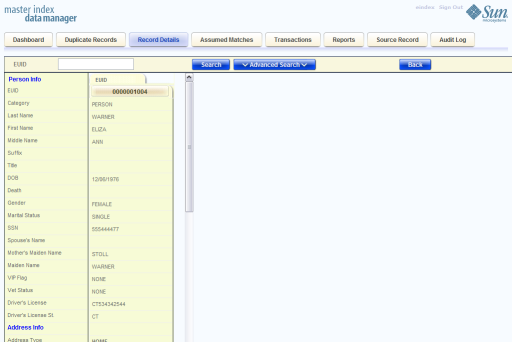
All source records for the profile appear in a side-by-side comparison view.
An image appears of both profiles as they were prior to the merge. This option is only available if the displayed profile is currently merged with another profile.
This option is only available if the displayed profile is currently merged with another profile.
The Source Record page displays source records in a series of search and view pages. You can view information associated with any of the SBR or source record components in an object profile. The source records associated with a profile contain the information that is stored in the external systems that share information with the master index application. The information in an object’s source records might not match the information stored in the object’s SBR.
Figure 17 Source Record Page in View Mode

Note - If the Local ID field allows alphabetic characters, the search is case-sensitive.
If the local ID is found, the source record fields appear in view mode.
The MIDM allows you to compare two or more object profiles side-by-side to check for similarities and differences. You can also compare different components of the same object profile and you can compare two or more source records from the same or different profiles.
To compare two or more object profiles, you can either perform an EUID comparison lookup from the Dashboard, or you can select multiple records from a Record Details search. From the resulting comparison page, you can compare the resulting profiles and you can view the source records for the displayed profiles.
Figure 18 Record Details Page - Multiple Object Profiles
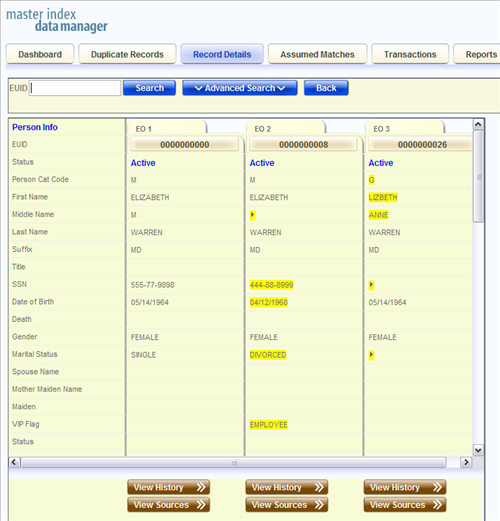
The records appear on the Record Details page in a side-by-side comparison view.
Tip - When you are done viewing the source records for a profile, click View Sources under that profile again to return to the comparison view.
Tip - When you are done viewing the transaction history for a profile, click View History under that profile again to return to the comparison view.
You can view the source records from one or more object profile displayed on the Record Details page in either view or comparison mode. This page does not provide merge functionality for source records. To merge source records, compare the records on the Source Record page as described in Viewing a Source Record on the MIDM.
Figure 19 Source Record Comparison From Record Details

The Record Details page appears with SBR information displayed.
The source records belonging to the displayed profile appear.
To compare source records directly without accessing them from an object profile, you need to know the system and local ID numbers for the records. On the Source Record page, you can only compare records that originated from the same system.
Figure 20 Source Records Comparison

Note - If any of the Local ID fields allows alphabetic characters, the search is case-sensitive.
Any matching source records appear side-by-side in a comparison view.
Tip - Clicking View EUID takes you out of the Source Records page and into the Record Details page. To return to the Source Record comparison page, click Back on the Record Details page.
Using the Transactions function, you can view historical information for a specific object and compare the object’s profile before and after a specific transaction occurred to determine what information was modified as a result of the transaction. You can access the transaction history for a profile from the Record Details page, or you can access transaction histories for one or more profiles from the Transactions page.
When you display a transaction history from the Record Details page, all of the transactions for the displayed object profile appear in chronological order, with the earliest transaction on the left and the most recent transaction on the right. When you display a transaction history record from the Transactions page, the image of the profile as it was prior to the transaction appears on the left side of the comparison page. The image on the right reflects the object’s information after the transaction occurred.
The profile appears on the Record Details page.
A history of all transactions performed against the object profile appears.
Figure 21 Transaction History on the Record Details Page
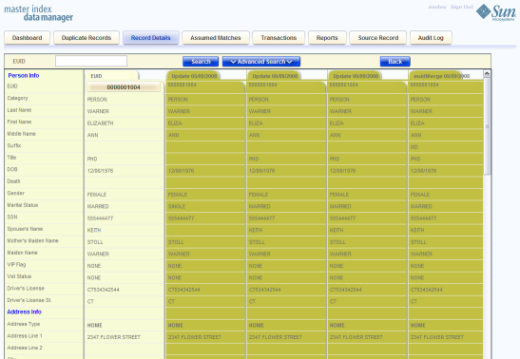
Figure 22 Transaction History Search Page
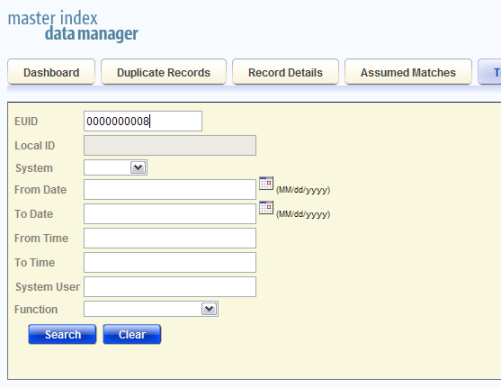
Note - The EUID field takes precedence over all other search fields on this page. You can only enter a local ID as search criteria after you have entered the corresponding system.
The Transaction History search results list appears with a list of matching transactions (for more information, see About Transaction History Results Fields on the MIDM).
Figure 23 Transaction History Results
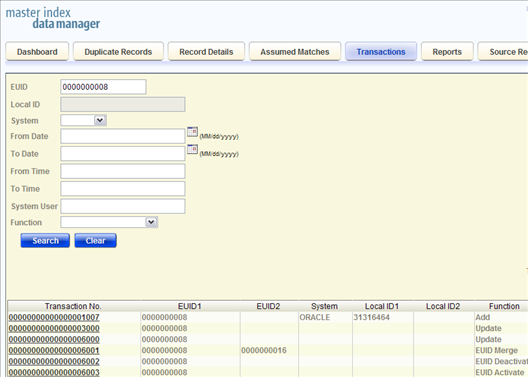
Figure 24 Transaction History Comparison Page
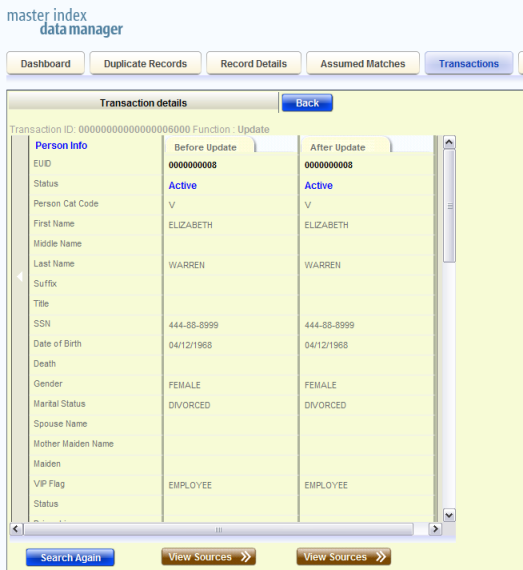
Note - If you are viewing an unmerge transaction, the active record prior to being unmerged is displayed on the left. The after image of the two records that were unmerged during the transaction is displayed on the right.
The fields located on the Transaction History Search page allow you to specify search criteria for the transactions you want to view. Note that the label for the Local ID field is customizable and might have been changed for your implementation. The search page can also be configured to display additional transaction fields. The following table lists the fields that are defined by default for a transaction history search.
Table 1 Transaction History Search Fields
|
The fields located in the Transaction History search results list help you identify a specific object profile and transaction to view. Additional fields might be added to this page by the system administrator. The LID field is configurable and might have been changed for your implementation.
Table 2 Transaction History Results Fields
|
Each transaction performed by the master index application is assigned a transaction type, indicating the type of action that was performed against the profile. The following table lists and describes each transaction type.
Table 3 Transaction Type Descriptions
|
When an object profile that is currently merged is displayed on the Record Details page, you can display a history of all merges performed against the profile, allowing you to trace the origin of certain information contained in the profile. The master index application tracks all merges performed against each object profile in the database. You can view a history of merges that affect a specific object profile and you can view each EUID that was merged to form the final merge result profile. The merge history appears in a tree structure on the Record Details page, showing each pair of profiles that were merged under the displayed object profile.
The Record Details page appears.
The Merge Tree popup window appears. You might need to scroll up to see the merge tree.
Figure 25 Merge History Tree

Figure 26 Merge Transaction History
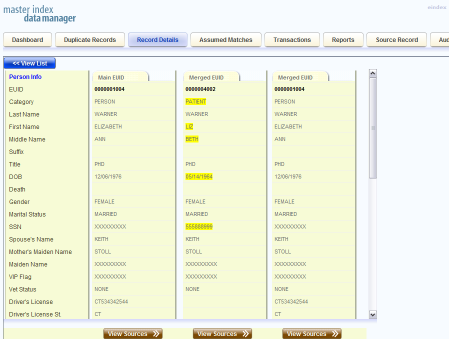
If the profile you are viewing on the Record Details page has been merged, you can view the merged profiles that were combined to create the currently displayed profile.
The Record Details page appears.
The profiles that were merged to create the current profile are displayed.
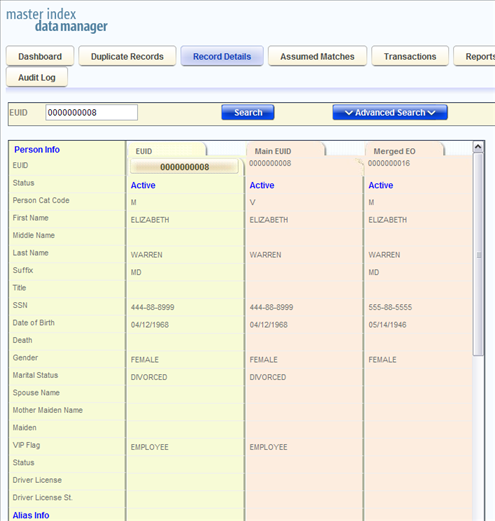
Using the Audit Log function, you can view a record of each instance an MIDM user accessed information about any object in the master index database. The audit log includes instances in which an object profile appeared in a search results list; was viewed or compared; was added, updated, or deactivated; or was merged or unmerged. The audit log can be enabled or disabled by the system administrator.
Figure 27 Audit Log Search Page

Note - The EUID field takes precedence over all other search fields on this page. You can only enter a local ID as search criteria after you have entered the corresponding system.
Figure 28 Audit Log Search Results List

The fields located on the Audit Log Search page allow you to enter search criteria about the audit log entries you want to view. These fields are configurable. The following table describes the fields that are displayed by default.
Table 4 Audit Log Search Fields
|
The fields located on the Audit Log Result page display information about the instances in which object data was accessed, where those instances match the search criteria you entered. These fields are configurable. The following table describes the fields that are displayed by default.
Table 5 Audit Log Results Fields
|
The audit log creates an audit entry whenever data is accessed through the MIDM. The following table lists and describes each audit log function. Some of these functions refer to the actual viewing of data on an MIDM page; others refer to an action taken against that data, such as clicking the merge or unmerge Confirm button or resolving a potential duplicate pair.
Table 6 Audit Log Function Descriptions
|